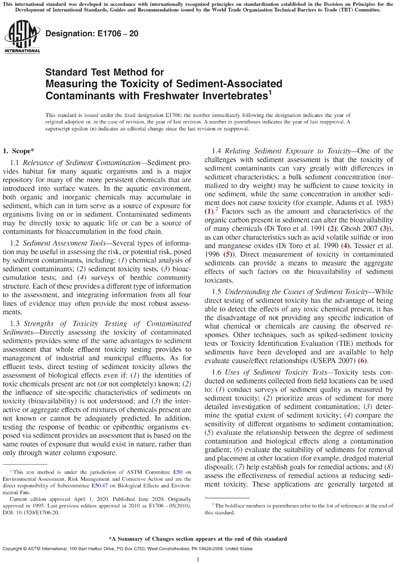Most recent
ASTM E1706-20
Standard Test Method for Measuring the Toxicity of Sediment-Associated Contaminants with Freshwater Invertebrates
1.1 Relevance of Sediment Contamination—Sediment provides habitat for many aquatic organisms and is a major repository for many of the more persistent chemicals that are introduced into surface waters. In the aquatic environment, both organic and inorganic chemicals may accumulate in sediment, which can in turn serve as a source of exposure for organisms living on or in sediment. Contaminated sediments may be directly toxic to aquatic life or can be a source of contaminants for bioaccumulation in the food chain.
1.2 Sediment Assessment Tools—Several types of information may be useful in assessing the risk, or potential risk, posed by sediment contaminants, including: (1) chemical analysis of sediment contaminants; (2) sediment toxicity tests, (3) bioaccumulation tests; and (4) surveys of benthic community structure. Each of these provides a different type of information to the assessment, and integrating information from all four lines of evidence may often provide the most robust assessments.
1.3 Strengths of Toxicity Testing of Contaminated Sediments—Directly assessing the toxicity of contaminated sediments provides some of the same advantages to sediment assessment that whole effluent toxicity testing provides to management of industrial and municipal effluents. As for effluent tests, direct testing of sediment toxicity allows the assessment of biological effects even if: (1) the identities of toxic chemicals present are not (or not completely) known; (2) the influence of site-specific characteristics of sediments on toxicity (bioavailability) is not understood; and (3) the interactive or aggregate effects of mixtures of chemicals present are not known or cannot be adequately predicted. In addition, testing the response of benthic or epibenthic organisms exposed via sediment provides an assessment that is based on the same routes of exposure that would exist in nature, rather than only through water column exposure.
1.4 Relating Sediment Exposure to Toxicity—One of the challenges with sediment assessment is that the toxicity of sediment contaminants can vary greatly with differences in sediment characteristics; a bulk sediment concentration (normalized to dry weight) may be sufficient to cause toxicity in one sediment, while the same concentration in another sediment does not cause toxicity (for example, Adams et al. 1985) (1).2 Factors such as the amount and characteristics of the organic carbon present in sediment can alter the bioavailability of many chemicals (Di Toro et al. 1991 (2); Ghosh 2007 (3)), as can other characteristics such as acid volatile sulfide or iron and manganese oxides (Di Toro et al. 1990 (4), Tessier et al. 1996 (5)). Direct measurement of toxicity in contaminated sediments can provide a means to measure the aggregate effects of such factors on the bioavailability of sediment toxicants.
1.5 Understanding the Causes of Sediment Toxicity—While direct testing of sediment toxicity has the advantage of being able to detect the effects of any toxic chemical present, it has the disadvantage of not providing any specific indication of what chemical or chemicals are causing the observed responses. Other techniques, such as spiked-sediment toxicity tests or Toxicity Identification Evaluation (TIE) methods for sediments have been developed and are available to help evaluate cause/effect relationships (USEPA 2007) (6).
1.6 Uses of Sediment Toxicity Tests—Toxicity tests conducted on sediments collected from field locations can be used to: (1) conduct surveys of sediment quality as measured by sediment toxicity; (2) prioritize areas of sediment for more detailed investigation of sediment contamination; (3) determine the spatial extent of sediment toxicity; (4) compare the sensitivity of different organisms to sediment contamination; (5) evaluate the relationship between the degree of sediment contamination and biological effects along a contamination gradient; (6) evaluate the suitability of sediments for removal and placement at other location (for example, dredged material disposal); (7) help establish goals for remedial actions; and (8) assess the effectiveness of remedial actions at reducing sediment toxicity. These applications are generally targeted at assessing the likely biological effects of bedded sediments at field sites at the time of sampling. However, toxicity testing of natural or artificial sediments spiked with known quantities of chemicals can also be used to evaluate additional questions such as: (1) determining the potency of a chemical to organisms exposed via sediment; (2) evaluating the effect of sediment composition on chemical bioavailability or toxicity; (3) informing chemical-specific risk assessments for chemicals that may accumulate and persist in sediments upon release; (4) establishing regulatory guidance for chemicals in water or sediment. Spiked sediment studies have the advantage of allowing uni-variate experiments in which exposure gradients can be reliably constructed; as such they lend themselves to the derivation of standardized point estimates of effect, such as a median lethal concentration (LC50) or concentration reducing sublethal performance by a specified amount, such as an effect concentration (for example, EC20 estimated to reduce weight of test organisms by 20 %).
1.7 Limitations—While some safety considerations are included in this standard, it is beyond the scope of this standard to encompass all safety requirements necessary to conduct sediment toxicity tests.
1.8 This standard is arranged as follows:
1.9 This standard does not purport to address all of the safety concerns, if any, associated with its use. It is the responsibility of the user of this standard to establish appropriate safety, health, and environmental practices and determine the applicability of regulatory limitations prior to use. Specific hazard statements are given in Section 8.
1.10 This international standard was developed in accordance with internationally recognized principles on standardization established in the Decision on Principles for the Development of International Standards, Guides and Recommendations issued by the World Trade Organization Technical Barriers to Trade (TBT) Committee.
ASTM International [astm]

